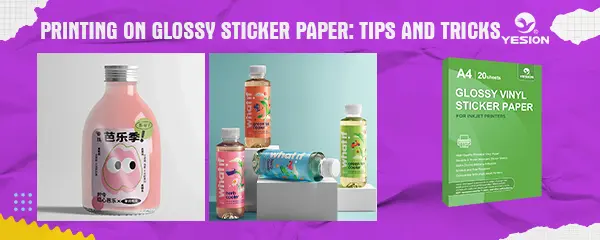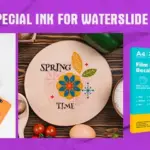
Do You Need Special Ink for Waterslide Paper?
2025-02-14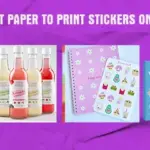
Printing on Glossy Sticker Paper: Tips and Tricks
2025-02-21When it comes to printing stickers, the choice of paper is essential to achieve the best results. Whether you’re creating custom stickers for your business, designing for personal projects, or just exploring the world of sticker printing, selecting the best paper is crucial to ensure your stickers have the durability, vibrancy, and quality that you expect. In this article, we will break down everything you need to know about sticker paper options, from materials to finishes, helping you make the right decision for your printing needs.
Understanding Sticker Paper Types
Before diving into specifics, it’s important to understand the two main types of sticker paper: matte and glossy. The choice between these types primarily depends on the look and feel you’re aiming for, as well as the intended use of the stickers. Here’s a breakdown of the different types of paper used for sticker printing.
Matte Sticker Paper
Matte sticker paper is a popular choice for those who want a non-glossy, smooth finish. It is often used for projects where the stickers will be applied to surfaces like books, laptops, or other areas where you want a subtle and refined look.
Advantages of matte sticker paper
No glare: Matte paper doesn’t reflect light, making it ideal for designs that require sharp contrast and clear visibility.
Writable surface: If you need to write on the stickers, matte paper offers a better surface for pens, markers, and pencils.
Professional look: Matte stickers can give a more sophisticated, understated appearance, which is great for branding or business applications.
Disadvantages
Less vibrant colors: While matte stickers can still look vibrant, they generally don’t pop as much as glossy stickers, which is something to consider for highly colorful designs.
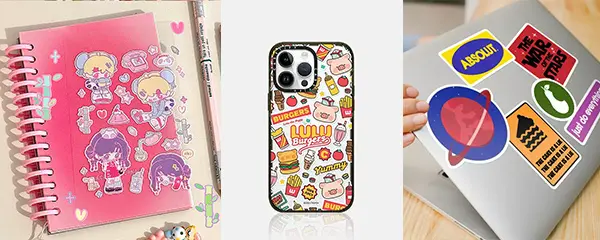
Matte Sticker
Glossy Sticker Paper
Glossy sticker paper, as the name suggests, has a shiny, smooth surface that adds a vibrant, reflective finish to your design. People commonly use this type of paper for photo stickers or designs where they want the colors to stand out.
Advantages of glossy sticker paper
Vibrant colors: Glossy paper enhances the saturation and brightness of your designs, making them stand out and appear more vibrant.
Durability: It is often more resistant to wear and tear compared to matte paper, especially for stickers exposed to moisture or handling.
Professional finish: The high-gloss finish gives stickers a polished, high-end appearance, making them perfect for product labels or eye-catching promotional materials.

glossy sticker
Disadvantages
Not writable: Glossy stickers are difficult to write on, so they may not be ideal for applications that require text or hand annotations.
Choosing the Best Paper for Sticker Printing
When selecting paper for your stickers, the material you choose is just as important as the finish. The most common types of paper for stickers include vinyl, kraft, paper, and clear. Below we explore the options in detail to help you decide which material suits your needs.
Vinyl Sticker Paper
Vinyl sticker paper is widely regarded as the best material for durable, high-quality stickers. This material is known for its waterproof, tear-resistant, and long-lasting properties, making it ideal for both indoor and outdoor applications.
Advantages of vinyl sticker paper
Waterproof: Vinyl is water-resistant, ensuring that your stickers can withstand exposure to the elements without fading or peeling.
Durable: Vinyl stickers last for years and are incredibly durable, making them perfect for items that people will handle frequently or expose to sunlight.
Wide applications: Vinyl stickers are versatile and suitable for a wide range of surfaces, including windows, cars, and outdoor equipment.
Disadvantages
Higher cost: Vinyl is often more expensive than other sticker materials, so it may not be the best option if you’re printing stickers in bulk on a budget.
Kraft Paper Sticker
Kraft sticker paper offers a rustic, eco-friendly look that is gaining popularity, especially for businesses with a sustainable or natural branding focus. It has a unique texture that adds character to designs and is often used in artisanal products or handcrafted items.
Advantages of kraft paper sticker
Eco-friendly: Kraft paper is made from recycled materials, making it a great choice for those who are environmentally conscious.
Unique texture: The textured surface of kraft paper gives your stickers a distinctive, natural appearance that’s great for businesses focused on organic or handmade products.
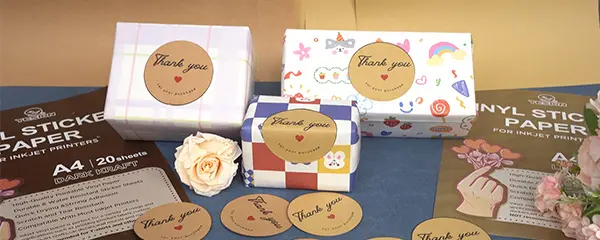
kraft sticker
Disadvantages
Limited vibrancy: Kraft paper offers a unique aesthetic, but it has more limited color options and printing capabilities compared to glossy or vinyl paper.
Paper Sticker Paper
Regular paper sticker paper is one of the most cost-effective options for printing stickers. It is a versatile material, often used for indoor applications or projects where temporary use is desired.
Advantages of paper sticker paper
Affordable: Paper stickers are budget-friendly and widely available, making them ideal for mass printing.
Variety: Paper stickers come in many finishes, including matte, glossy, and semi-gloss, providing options to suit different needs.
Disadvantages
Less durable: Paper stickers are not as durable as vinyl or other materials, and they are more likely to tear or fade over time.
Not waterproof: Paper stickers can get damaged when exposed to water or moisture.
Clear Sticker Paper
Clear sticker paper is a unique material that allows for see-through designs. These stickers can create a sleek, transparent look, making them perfect for adding designs to glass surfaces, like windows or jars, without obstructing the view behind them.
Advantages of clear sticker paper
Transparent effect: Clear stickers are perfect for designs that blend seamlessly into their background, especially on glass, windows, or bottles.
Clean and modern appearance: The clear nature of the paper offers a clean, minimalist aesthetic, making them ideal for logos, brand marks, or subtle decorative elements.
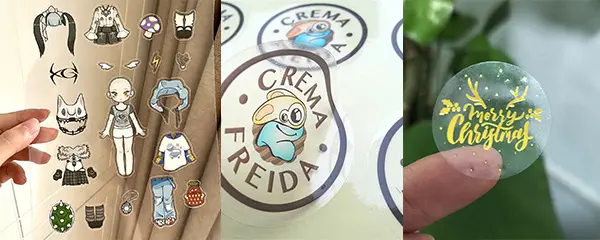
clear sticker
Disadvantages
Limited opacity: Depending on the design, clear stickers may not be as vibrant as their opaque counterparts, and the background surface may influence the final appearance.
Best Practices for Printing Stickers
Once you’ve selected the best paper for your stickers, it’s time to get printing. Here are some best practices to ensure you achieve the highest quality results when printing your stickers:
Use a high-quality printer: Invest in a inkjet or laser printer that delivers crisp, vibrant prints. A printer with higher resolution capabilities will result in sharper details and better color accuracy.
Choose the right ink: Ensure you’re using ink that is compatible with the paper type. For instance, inkjet printers require specific ink formulations that work well with matte or glossy paper.
Print in high resolution: Always set your print quality to high resolution when printing stickers. This method ensures that fine details and colors render sharply.
Allow stickers to dry properly: After printing, let the stickers dry completely before handling them. This helps prevent smudging or smearing, especially on glossy papers.
Consider using a cutting machine: If you’re printing large batches of stickers, consider using a die-cutting machine to create uniform shapes and sizes.
Choosing the best paper for printing stickers is crucial to achieving the desired results. You can choose vinyl for durability, kraft for a rustic look, or glossy paper for vibrant colors. There is a sticker paper to suit your needs. Always consider the purpose of your stickers, the surface for application, and how long they need to last when selecting the best paper.
Related:
What Are the Different Types of Vinyl Sticker Paper?
Vinyl vs. Paper-Based Sticker Paper: What’s the Difference?
Best Vinyl Sticker Paper For Inkjet Printer
Why are most vinyl sticker papers only compatible with inkjet printers?

